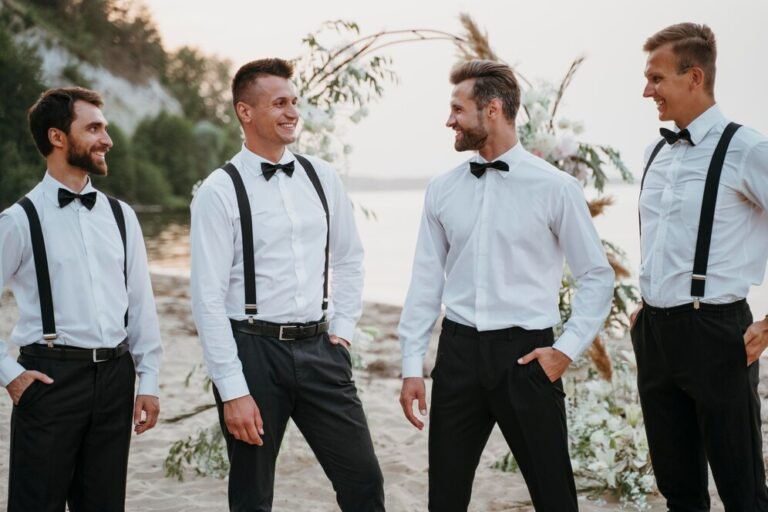Attending a black tie wedding guest dress means stepping into a world of elevated sophistication, where style and grace are non-negotiable. Unlike casual or semi-formal events, a black tie invitation sets a clear tone—it calls for formal evening wear that respects tradition while offering room for personal flair. For women, this typically translates to floor-length gowns or ultra-elegant cocktail dresses, while men are expected to don tuxedos. Navigating the dress code as a guest can feel overwhelming, especially with the countless options available and the pressure to look polished yet appropriate. This article will break down everything you need to know—from dress options to color etiquette and accessorizing—so you can arrive in style and confidence, embodying the refined elegance that black tie weddings demand.
Understanding the Black Tie Dress Code
The term “black tie” may sound straightforward, but it comes with a distinct set of fashion expectations that must be honored to avoid standing out for the wrong reasons. Traditionally, black tie events are held in the evening and call for formal attire that reflects the grandeur of the occasion. For men, this is usually a black tuxedo, crisp white shirt, black bow tie, and polished dress shoes. For women, the range of acceptable attire is broader but no less formal—full-length gowns in luxurious fabrics like silk, satin, or velvet are most appropriate, although a well-tailored midi dress with sophisticated embellishments may also pass. The key is to aim for elegance and refinement, steering clear of casual fabrics, flashy designs, or anything too revealing. Dressing appropriately not only shows respect for the hosts but also contributes to the overall aesthetic and formality of the event.
Choosing the Perfect Dress: Styles That Stand Out
When selecting your black tie wedding guest dress, the most important factors are silhouette, fabric, and fit. A floor-length gown remains the gold standard for black tie affairs, offering a timeless and dramatic look that’s perfect for evening events. Classic A-line dresses flatter most body types and exude effortless grace, while mermaid and sheath styles add a touch of modern sophistication. Fabrics like chiffon, tulle, lace, or sequined materials can add texture and glamour without being too overpowering. It’s also worth considering the location and season of the wedding—lighter fabrics are perfect for summer soirées, while velvets and brocades suit winter weddings beautifully. Always prioritize fit; a well-fitted dress enhances confidence and poise, ensuring you look and feel your best all evening long.
What Colors Are Best for a Black Tie Wedding?
Color plays a crucial role in achieving the right black tie look. Deep, rich tones such as navy, emerald green, burgundy, and classic black are always safe choices that convey elegance and luxury. Jewel tones work especially well for evening weddings, creating a sophisticated and regal aesthetic under ambient lighting. Pastels and lighter hues can also work in warmer months or destination weddings, but be sure they don’t appear too casual or beachy. One unspoken rule is to avoid wearing white or anything too close to it, as this remains reserved for the bride. Metallics like gold or silver can add a festive touch when done tastefully—think subtle shimmer rather than head-to-toe sequins. Ultimately, your goal is to complement the wedding’s formality while expressing your personal style in a respectful, tasteful way.
Accessories That Elevate Your Ensemble
The right accessories can transform a black tie wedding guest dress into a head-turning outfit. For black tie events, go for statement pieces that enhance your gown without overwhelming it. A pair of chandelier earrings, a sleek clutch, and a delicate bracelet can strike the perfect balance between glamour and restraint. Footwear should be elegant and formal—opt for heeled sandals or pumps in neutral or metallic tones, and make sure they’re comfortable enough to last the evening. Consider a wrap or shawl for warmth if the event is outdoors or during cooler months. Your hair and makeup should also reflect the elevated tone; think polished hairstyles like low buns or soft curls, and a makeup look that’s bold yet refined. Every detail, from your nail color to your fragrance, contributes to the overall sophistication that black tie demands.
What to Avoid: Common Black Tie Faux Pas
While there’s room for creativity within the black tie dress code, certain mistakes can undermine your entire look. Avoid casual fabrics like cotton or jersey, even if the cut of the dress appears formal. Steer clear of overly revealing attire—deep plunging necklines, high slits, or backless gowns may be better suited to red carpets than weddings. Be cautious with prints; while some florals or subtle patterns can work, loud or quirky designs might clash with the elegant atmosphere. Over-accessorizing can also be a misstep; too many sparkles or oversized jewelry pieces can detract from the sophistication of your ensemble. Most importantly, avoid upstaging the bride—this is her moment, and your outfit should celebrate her while still allowing you to shine in your own refined way.
Conclusion: Dress to Impress with Grace
Navigating a black tie wedding doesn’t have to be daunting if you approach it with an understanding of the occasion’s expectations and a touch of personal flair. Choosing the right dress, color palette, and accessories will not only ensure that you adhere to the formal dress code but also help you feel confident and graceful throughout the event. Remember, the goal is to strike a perfect balance between elegance and effortlessness, respecting the formality of the occasion while expressing your individual style with class. With the right preparation and attention to detail, your black tie wedding guest look will leave a lasting impression—for all the right reasons.

